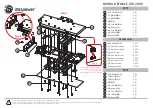
Chapter 4
Signal Connections
©
National Instruments Corporation
4-13
6711/6713/6715 User Manual
Programmable Function Input Connections
There are a total of seven internal timing signals that you can externally
control from the PFI pins. The source for each of these signals is
software-selectable from any of the PFIs when you want external control.
This flexible routing scheme reduces the need to change the physical
wiring to the device I/O connector for different applications requiring
alternative wiring.
You can individually enable six of the PFI pins to output a specific internal
timing signal. For example, if you need the UPDATE* signal as an output
on the I/O connector, software can turn on the output driver for the
PFI5/UPDATE* pin. Be careful not to drive a PFI signal externally when it
is configured as an output.
As an input, you can individually configure each PFI for edge or level
detection and for polarity selection, as well. You can use the polarity
selection for any of the seven timing signals, but the edge or level detection
will depend upon the particular timing signal being controlled. The
detection requirements for each timing signal are listed within the section
that discusses that individual signal.
In edge-detection mode, the minimum pulse width required is 10 ns. This
applies for both rising-edge and falling-edge polarity settings. There is no
maximum pulse-width requirement in edge-detect mode.
In level-detection mode, there are no minimum or maximum pulse-width
requirements imposed by the PFIs themselves, but there can be limits
imposed by the particular timing signal being controlled. These
requirements are listed later in this chapter.
EXTSTROBE* Signal
EXTSTROBE* is an output-only signal that is used for controlling SCXI
devices.
Artisan Technology Group - Quality Instrumentation ... Guaranteed | (888) 88-SOURCE | www.artisantg.com
















































